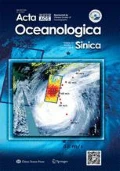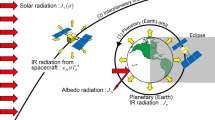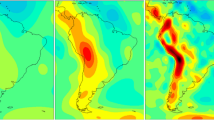Abstract
The extremely low temperature, high humidity and limited power supply pose considerable challenges when using spectrometers within the Arctic sea ice. The feasibility of using a miniature low-power near-infrared spectrometer module to measure solar radiation in Arctic sea ice environments was investigated in this study. Temperature and integration time dependences of the spectrometer module were examined over the entire target operating range of −50°C to 30°C, well below the specified operating range of this spectrometer. Using these observations, a dark output prediction model was developed to represent dark output as a function of temperature and integration time. Temperature-induced biases in the saturation output and linear operating range of the spectrometer were also determined. Temperature and integration time dependences of the signal output were evaluated. Two signal output correction models were developed and compared, to convert the signal output at any temperature within the operating temperature range and integration time to that measured at the reference temperature and integration time. The overall performance of the spectrometer was evaluated by integrating it into a refined fiber optic spectrometry system and measuring solar irradiance distribution in the ice cover with thickness of 1.85 m in the Arctic during the 9th Chinese National Arctic Research Expedition. The general shape of the measured solar irradiance above the snow surface agreed well with that measured by other commercial oceanographic spectroradiometers. The measured optical properties of the sea ice were generally comparable to those of similar ice measured using other instruments. This approach provides a general framework for assessing the feasibility of using spectrometers for applications in cold environments.
Similar content being viewed by others
References
Campbell K, Mundy C J, Barber D G, et al. 2015. Characterizing the sea ice algae chlorophyll a-snow depth relationship over Arctic spring melt using transmitted irradiance. Journal of Marine Systems, 147: 76–84, doi: https://doi.org/10.1016/j.jmarsys.2014.01.008
Comiso J C, Parkinson C L, Gersten R, et al. 2008. Accelerated decline in the Arctic sea ice cover. Geophysical Research Letters, 35(1): L01703
Ehn J K, Papakyriakou T N, Barber D G. 2008. Inference of optical properties from radiation profiles within melting landfast sea ice. Journal of Geophysical Research: Oceans, 113(C9): C09024
Ehn J K, Mundy C J, Barber D G, et al. 2011. Impact of horizontal spreading on light propagation in melt pond covered seasonal sea ice in the Canadian Arctic. Journal of Geophysical Research: Oceans, 116(C9): C00G02
Feister U, Grewe R. 1995. Spectral albedo measurements in the UV and visible region over different types of surfaces. Photochemistry and Photobiology, 62(4): 736–744, doi: https://doi.org/10.1111/j.1751-1097.1995.tb08723.x
Frey K E, Perovich D K, Light B. 2011. The spatial distribution of solar radiation under a melting Arctic sea ice cover. Geophysical Research Letters, 38(22): L22501
Grenfell T C, Light B, Perovich D K. 2006. Spectral transmission and implications for the partitioning of shortwave radiation in arctic sea ice. Annals of Glaciology, 44: 1–6
Grenfell T C, Perovich D K. 1981. Radiation absorption coefficients of polycrystalline ice from 400–1400 nm. Journal of geophysical research, 86(C8): 7447–7450
Kuusk J. 2011. Dark signal temperature dependence correction method for miniature spectrometer modules. Journal of Sensors, 2011: Article ID 608157
Lei Ruibo, Leppäranta M, Erm A, et al. 2011. Field investigations of apparent optical properties of ice cover in Finnish and Estonian lakes in winter 2009. Estonian Journal of Earth Sciences, 60(1): 50, doi: https://doi.org/10.3176/earth.2011.1.05
Lei Ruibo, Zhang Zhanhai, Matero I, et al. 2012. Reflection and transmission of irradiance by snow and sea ice in the central Arctic Ocean in summer 2010. Polar Research, 31(1): 17325, doi: https://doi.org/10.3402/polar.v31i0.17325
Light B, Grenfell T C, Perovich D K. 2008. Transmission and absorption of solar radiation by Arctic sea ice during the melt season. Journal of Geophysical Research: Oceans, 113(C3): 03023, doi: https://doi.org/10.1029/2006JC003977
Maslanik J A, Fowler C, Stroeve J, et al. 2007. A younger, thinner Arctic ice cover: Increased potential for rapid, extensive sea-ice loss. Geophysical Research Letters, 34(24): L24501, doi: https://doi.org/10.1029/2007GL032043
Maslanik J, Stroeve J, Fowler C, et al. 2011. Distribution and trends in Arctic sea ice age through spring 2011. Geophysical Research Letters, 38(13): L13502
Min M, Lee W S, Burks T F, et al. 2008. Design of a hyperspectral nitrogen sensing system for orange leaves. Computers and Electronics in Agriculture, 63(2): 215–226, doi: https://doi.org/10.1016/j.compag.2008.03.004
Nicolaus M, Hudson S R, Gerland S, et al. 2010. A modern concept for autonomous and continuous measurements of spectral albedo and transmittance of sea ice. Cold Regions Science and Technology, 62(1): 14–28, doi: https://doi.org/10.1016/j.coldregions.2010.03.001
Nicolaus M, Katlein C. 2013. Mapping radiation transfer through sea ice using a remotely operated vehicle (ROV). The Cryosphere, 7(3): 763–777, doi: https://doi.org/10.5194/tc-7-763-2013
Palmer M A, Saenz B T, Arrigo K R. 2014. Impacts of sea ice retreat, thinning, and melt-pond proliferation on the summer phytoplankton bloom in the Chukchi Sea, Arctic Ocean. Deep Sea Research Part II: Topical Studies in Oceanography, 105: 85–104, doi: https://doi.org/10.1016/j.dsr2.2014.03.016
Perovich D K, Grenfell T C, Light B, et al. 2002. Seasonal evolution of the albedo of multiyear Arctic sea ice. Journal of Geophysical Research: Oceans, 107(C10): SHE 20–1–SHE 20–13
Perovich D K, Jones K F, Light B, et al. 2011. Solar partitioning in a changing Arctic sea-ice cover. Annals of Glaciology, 52(57): 192–196, doi: https://doi.org/10.3189/172756411795931543
Pirazzini R, Vihma T, Granskog M A, et al. 2006. Surface albedo measurements over sea ice in the Baltic Sea during the spring snowmelt period. Annals of Glaciology, 44: 7–14, doi: https://doi.org/10.3189/172756406781811565
Riihelä A, Manninen T, Laine V. 2013. Observed changes in the albedo of the Arctic sea-ice zone for the period 1982–2009. Nature Climate Change, 3(10): 895–898, doi: https://doi.org/10.1038/nclimate1963
Serreze M C, Holland M M, Stroeve J. 2007. Perspectives on the Arctic’s shrinking sea-ice cover. Science, 315(5818): 1533–1536, doi: https://doi.org/10.1126/science.1139426
Stroeve J C, Serreze M C, Holland M M, et al. 2012. The Arctic’s rapidly shrinking sea ice cover: a research synthesis. Climatic Change, 110(3–4): 1005–1027
Treffeisen R, Krejci R, Ström J, et al. 2007. Humidity observations in the Arctic troposphere over Ny-Ålesund, Svalbard based on 15 years of radiosonde data. Atmospheric Chemistry and Physics, 7(10): 2721–2732, doi: https://doi.org/10.5194/acp-7-2721-2007
Wang Hangzhou, Chen Ying, Song Hong, et al. 2014. A fiber optic spectrometry system for measuring irradiance distributions in sea ice environments. Journal of Atmospheric and Oceanic Technology, 31(12): 2844–2857, doi: https://doi.org/10.1175/JTECH-D-14-00108.1
Author information
Authors and Affiliations
Corresponding author
Additional information
Foundation item
The National Natural Science Foundation of China under contract Nos 41976218 and 41606214; the National Key Research and Development Program of China under contract No. 2016YFC1400303; the Fundamental Research Funds for the Central Universities under contract No. 2018FZA4022.
Rights and permissions
About this article
Cite this article
Nan, L., Wang, X., Wang, H. et al. Feasibility study of miniature near-infrared spectrometer for the measurement of solar irradiance within Arctic snow-cover sea ice. Acta Oceanol. Sin. 39, 115–124 (2020). https://doi.org/10.1007/s13131-020-1632-y
Received:
Accepted:
Published:
Issue Date:
DOI: https://doi.org/10.1007/s13131-020-1632-y




